If you’ve ever gone down your basement on a chilly morning and felt the chill seeping through the walls and floor, you already know why proper insulation is required in Ontario. Whether you are located in Hamilton, Toronto, Mississauga, or Oakville, you spend most of the year in the cold. A poorly sealed or uninsulated basement is one of the most common causes of heat loss, moisture buildup, and high energy expenses. Proper insulation material for your basement not only keeps you comfortable but also protects you from mildew, moisture, and costly finish damage. It’s not enough to keep your basement warm; you also need to keep it dry, healthy, and ready for any remodeling or legal secondary suite addition.
Despite basement walls below grade behaving differently from the rest of the house, homeowners frequently assume that any form of insulation will be effective. Temperature fluctuations and soil moisture put them under continual strain. The incorrect insulation choice could fail in a few years, create mold, or trap moisture. Choosing the best basement insulation material in Ontario includes more than just the upfront cost; it also involves combining performance, moisture control, and durability over the years.
How Ontario’s Climate and Building Conditions Affect Your Basement
The GTA’s temperature and soil composition present special issues for basements. The combination of regular freeze-thaw cycles, humid summers, and frigid winters strains foundations. The foundation walls of your house will constantly absorb and release moisture, whether they are made of block or concrete. It also means that even though your basement may seem dry, the concrete is never completely dry since condensation forms when warm interior air meets cold walls, which is when the majority of mold problems that we encounter during basement reconstruction efforts in Toronto and the surrounding areas.
The Ontario Building Code sets strict standards for insulation R-values, air barriers, and vapour retarders in below-grade spaces. Using the wrong basement insulation material can result in failed inspections or moisture issues down the road. Failing to meet these standards can affect energy performance and even cause a failed inspection when converting to a legal basement apartment. The good news? The right materials and methods not only meet code but also create a far more comfortable and energy-efficient space.
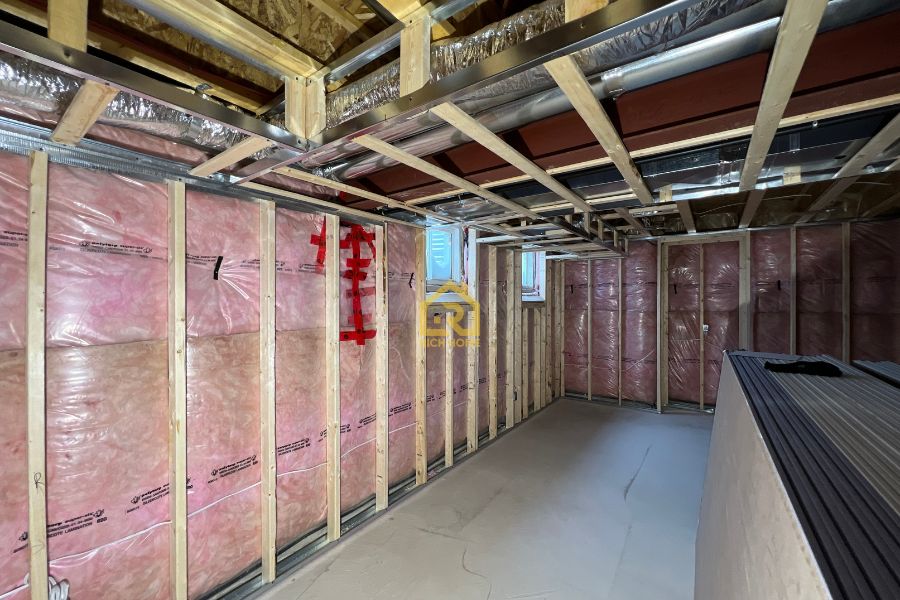
The Best Basement Insulation Materials Explained
Not all basement insulation materials perform the same way below grade. Here’s an in-depth look at the main types, their strengths, limitations, and ideal applications.
1. Closed-Cell Spray Foam (CCSPF)
Closed-cell spray foam consistently ranks as the top performer for Ontario basements. It adheres directly to concrete, expands into cracks, and provides both high R-value (around R-6 to R-7 per inch) and exceptional moisture resistance. When applied at 2–3 inches, it serves as both an air barrier and a vapour retarder, reducing condensation and improving comfort immediately.
Pros:
- Excellent for air sealing and moisture control
- Doesn’t absorb water or support mould
- Saves space compared to framed systems
Cons:
- Higher upfront cost
- Must be installed by certified professionals
- Requires fire-rated covering (such as drywall) per Ontario Building Code
We typically recommend spray foam for homeowners planning a full basement remodel or when finishing walls that are uneven or hard to access. It’s also perfect for sealing rim joists and sill plates, two of the most overlooked heat loss points.
2. Rigid Foam Board Insulation (XPS, EPS, Polyiso)
Rigid foam boards are another top choice for insulating basement walls in the GTA. They’re cost-effective, easy to cut and install, and offer excellent thermal performance.
XPS (extruded polystyrene) offers about R-5 per inch and resists moisture well. EPS (expanded polystyrene) is more affordable but slightly less dense, requiring thicker layers to achieve the same R-value. Polyiso has the highest R-value per inch but performs best in above-freezing conditions, so it’s typically used in combination assemblies.
Pros:
- Great moisture resistance when seams are taped
- Can be installed by professionals or skilled DIYers
- Works well behind framed walls
Cons:
- Must be properly sealed at seams to prevent air leaks
- Exposed foam must be covered by drywall for fire protection
We often use rigid foam boards behind new stud walls in basement redesign because they provide a smooth, dry base for wiring and finishing while protecting the concrete structure.
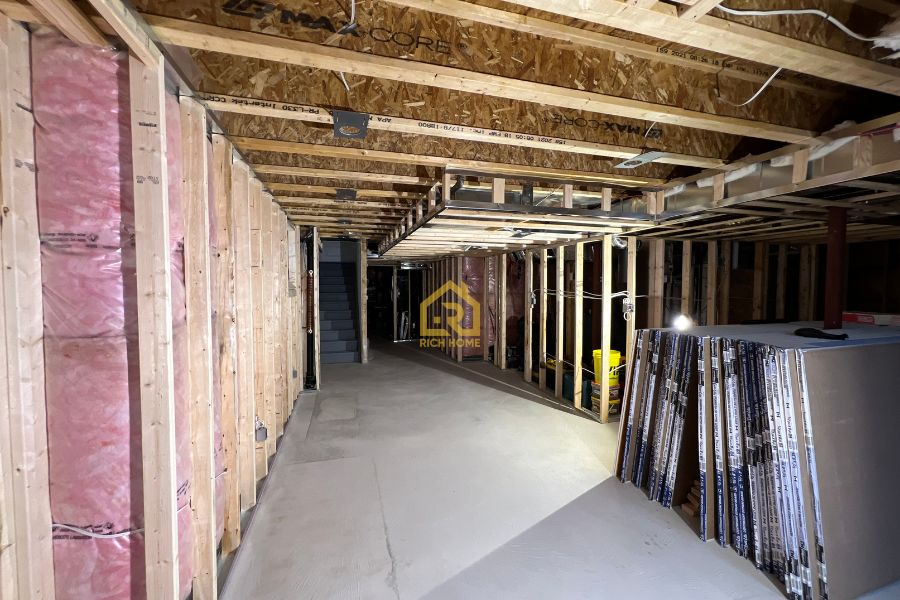
3. Mineral Wool (Rockwool)
Mineral wool insulation is ideal for homeowners looking for fire resistance and soundproofing. It doesn’t absorb water or support mould growth and is easy to install in stud cavities. However, it isn’t an air or vapour barrier, so it must be used with a proper moisture control layer.
Pros:
- Fire-resistant and sound-absorbing
- Sustainable and non-combustible
- Performs well when paired with rigid foam
Cons:
- Not a standalone air barrier
- Loses efficiency if installed against damp concrete
4. Fiberglass Batts
Fiberglass remains a common choice for budget-conscious projects, but it should never be installed directly against concrete walls. It’s only suitable in dry, framed walls that already have a moisture barrier behind them.
Pros:
- Inexpensive and widely available
- Works well above grade
Cons:
- Loses R-value when wet
- It can trap moisture and cause mould if improperly installed
5. Exterior Foundation Insulation
For homeowners planning major excavation or waterproofing, exterior insulation is the gold standard. It keeps the concrete warm, reduces frost movement, and protects waterproofing membranes. However, it’s expensive and disruptive, making it best suited for new construction or major foundation work.
Comparing Common Basement Insulation Materials
Insulation Type | R-Value (per inch) | Moisture Resistance | Air Barrier | DIY Friendly | Typical Application |
|---|---|---|---|---|---|
| Closed-Cell Spray Foam | R-6 to R-7 | Excellent | Yes | No | Directly on concrete or rim joists |
| XPS Rigid Foam | R-5 | Very Good | With taped seams | Moderate | Interior or exterior walls |
| EPS Rigid Foam | R-4 | Good | With taped seams | Yes | Budget interior insulation |
| Polyiso | R-6 | Fair below freezing | With taped seams | Yes | Hybrid systems |
| Mineral Wool | R-4 | Good but not waterproof | No | Yes | Framed walls with vapour control |
| Fiberglass Batts | R-3.5 | Poor | No | Yes | Only over vapor-protected framing |
Moisture, Vapour, and Air Control
Moisture is the silent enemy of basements. Many homeowners rush to insulate without addressing leaks, cracks, or damp walls. Before installing any insulation, perform a thorough inspection. Look for efflorescence (white mineral stains), wet patches, or musty smells. These are signs that moisture is already seeping through. Waterproofing and proper grading outside the home should come first.
For interior insulation, always include a capillary break between concrete and fibrous insulation. A layer of rigid foam or spray foam provides that buffer. The vapour control layer depends on your chosen system: closed-cell spray foam serves as its own vapour retarder, while rigid foam assemblies need properly sealed seams and, in some cases, a smart vapour barrier on the warm side.
Avoid installing polyethylene sheeting directly over concrete behind insulation, as it can trap moisture and lead to mould. Each assembly must be designed for the specific basement conditions.
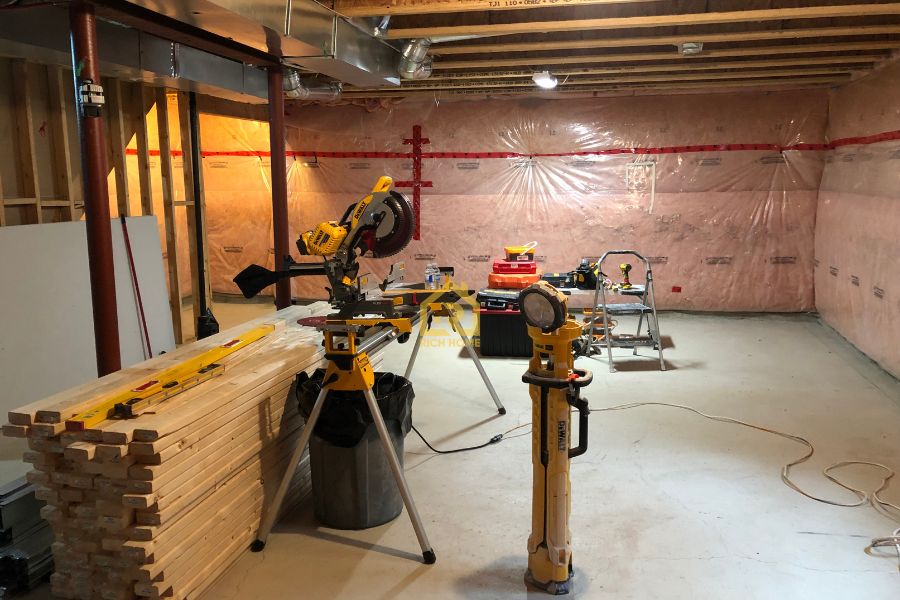
Basement Insulation Installation Techniques: Professional vs DIY
Basement insulation might look simple, but below-grade work is complex. There are safety codes, vapour control requirements, and moisture risks that can turn a weekend project into an expensive fix.
DIY is realistic for homeowners using rigid foam boards on interior walls. You can adhere the boards with approved adhesive, tape the seams, and then install furring strips or a stud wall. However, improper sealing can lead to air leaks, condensation, and insulation failure.
Professional installation becomes essential when using closed-cell spray foam, dealing with uneven foundations, or combining waterproofing and insulation. Our team regularly handles these projects as part of full basement remodeling services in Oakville, ensuring the insulation meets code, performs efficiently, and integrates with electrical, HVAC, and plumbing work.
Cost & Performance Comparison For Different Insulation Materials For Basement
Material Type | Approx. Installed Cost (per sq. ft.) | Longevity | Maintenance | Best For |
|---|---|---|---|---|
| Closed-Cell Spray Foam | $10–$20+ | 25+ years | Minimal | Maximum performance, moisture control |
| Rigid Foam Boards (XPS/EPS) | $6–$15 | 20–30 years | Low | Balanced cost and efficiency |
| Mineral Wool (in framed walls) | $5–$12 | 20+ years | Moderate | Fire and sound resistance |
| Fiberglass Batts | $3–$6 | 10–15 years | Moderate to high | Budget finishing in dry areas |
| Exterior Foundation Insulation | $50–$150 per linear foot | 40+ years | Low | New builds or major waterproofing |
Costs are approximate and depend on wall condition, access, and local pricing across the GTA.
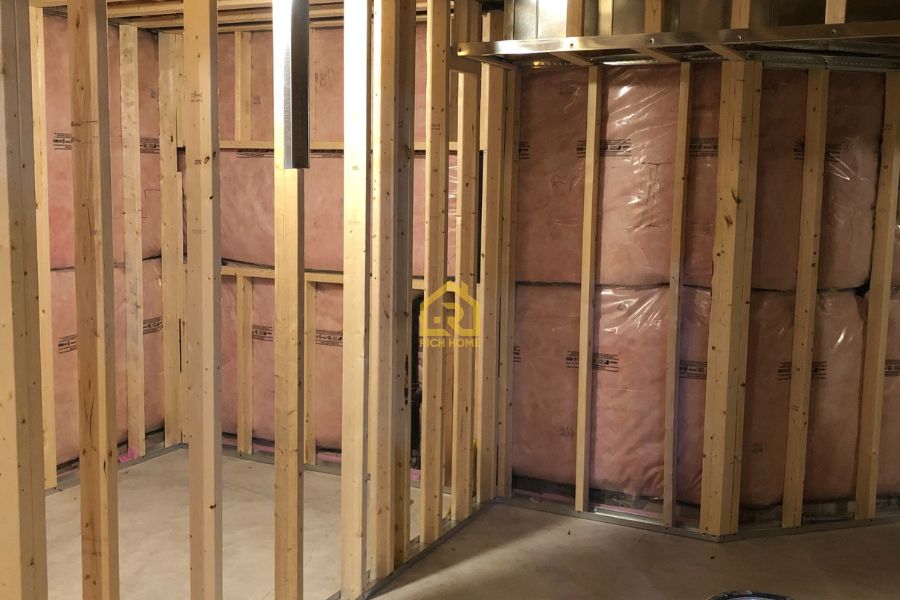
Common Mistakes In Insulation Material and How to Avoid Them
- Installing fiberglass directly on concrete without a vapour break
- Using plastic sheeting where walls need to breathe
- Ignoring rim joists and sill plates during insulation
- Covering damp foundations without waterproofing
- Failing to comply with fire-protection codes for foam plastics
- Neglecting ventilation after insulation, every finished basement needs balanced airflow
We frequently see basements where homeowners used the wrong materials or skipped critical air-sealing steps. The result? Peeling paint, musty smells, and ruined drywall within two winters. The solution always comes down to doing it right the first time: choose materials that suit Ontario’s moisture-heavy conditions and follow proper installation methods.
Choosing the Right Insulation Material for Your Home
The best outcomes are obtained using a mixed strategy for the majority of GTA properties. This calls for a 2×4 stud wall insulated with mineral wool after 2 inches of stiff foam is placed directly on the concrete walls and sealed at the joints. This combination is ideal for finished living spaces or legal basement suites because it provides robust thermal protection, moisture control, and sound absorption.
For the greatest efficiency and air sealing, closed-cell spray foam continues to be the best option. The comfort, longevity, and lower energy expenses soon make the higher initial cost worthwhile. Rigid foam by itself may be sufficient for storage or unfinished basements.
Local Considerations Across the Greater Toronto Area
Each city across the GTA presents different basement challenges. In Toronto, many older homes have stone or rubble foundations requiring spray foam or interior foam systems that conform to irregular surfaces. In Mississauga and Oakville, we often find poured concrete walls with minor dampness issues where rigid foam with taped seams works best. Whereas in Hamilton, older basements frequently need drainage upgrades before insulation can safely go in.
Regardless of city, local bylaws and building codes require proper vapour barriers, R-values, and fire-rated finishes. Always confirm your design meets the Ontario Building Code, suggestions by the Government of Canada of keeping heat in the basement by insulation, and obtain necessary permits before starting your project.
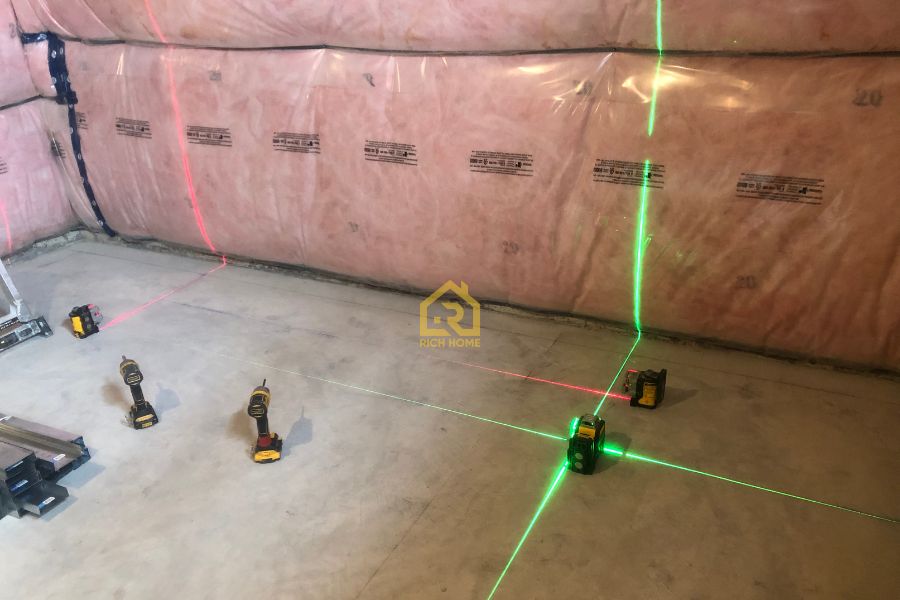
Long-Term Performance and Maintenance
A well-insulated basement shouldn’t need frequent attention, but it’s wise to inspect for leaks, humidity buildup, or damaged finishes once a year. Keep dehumidifiers running in summer and make sure sump pumps and drainage systems function properly. With proper installation and moisture control, quality insulation systems easily last decades without performance loss.
So, Should You Call The Basement Redesigning Contractors?
Whether you’re planning a complete makeover with new flooring, drywall, and egress restoration, or you’re just wondering if your basement walls are dry enough for insulation, professional help is crucial. Complete design-to-build services, including framing, finishing, insulation, and waterproofing, are provided by our knowledgeable staff. We ensure that the insulation system not only functions well but also supports your long-term renovation objectives, whether you’re turning the space into a rental unit, installing a basement egress window, or lowering the floor to meet the permitted basement height.
Insulate Your Basement Once, Enjoy for Decades
Your foundation type, moisture content, and price range will determine the best basement insulation material for your home, but the end objective is always the same: to create a durable, dry, and energy-efficient space. When used properly, mineral wool offers comfort and sound control, rigid foam systems nicely balance cost and performance, and closed-cell spray foam delivers the best protection. The correct materials and a reliable contractor are the first steps in completing your basement for family use or to increase its resale potential.
Get in touch with us for a consultation or on-site evaluation if you’re prepared to make your basement dry, comfortable, and code-compliant. Our experts take care of every aspect of your basement, assist you in selecting the best insulation material, and promise perfect installations.
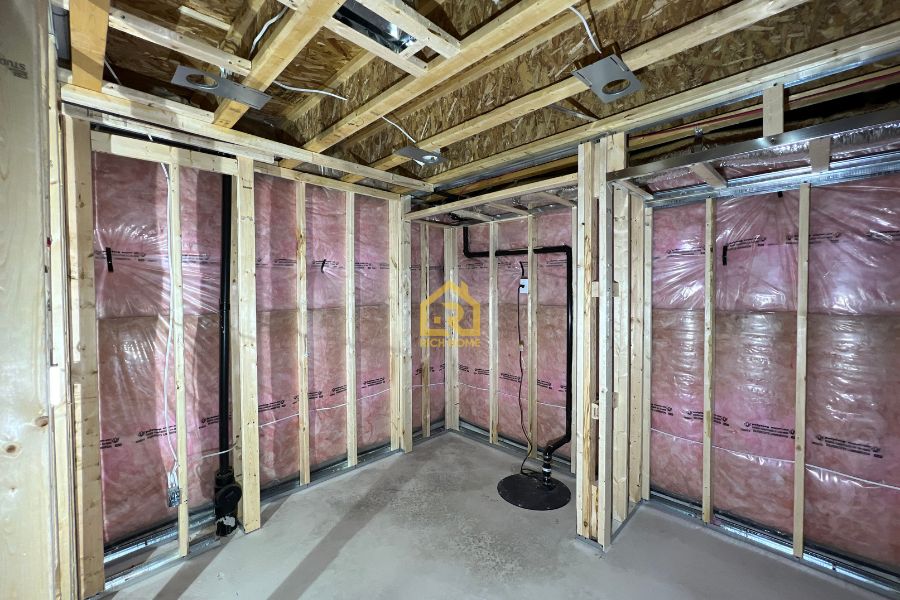
Areas We Serve
We are proud to offer our Home Renovation services in the following areas:
Hamilton
Burlington
Oakville
Milton
Mississauga
Toronto
Contact Info
Send us a message or call us and we’ll get back to you as soon as we can.
Valid until end of month
book now for SPECIAL saving!
free estimate
(647) 994-1439
have a questions?
info@richhomeinc.ca
Get Started Today
Transform your home with Rich Home Inc. Contact us now for a free consultation and begin your renovation journey!